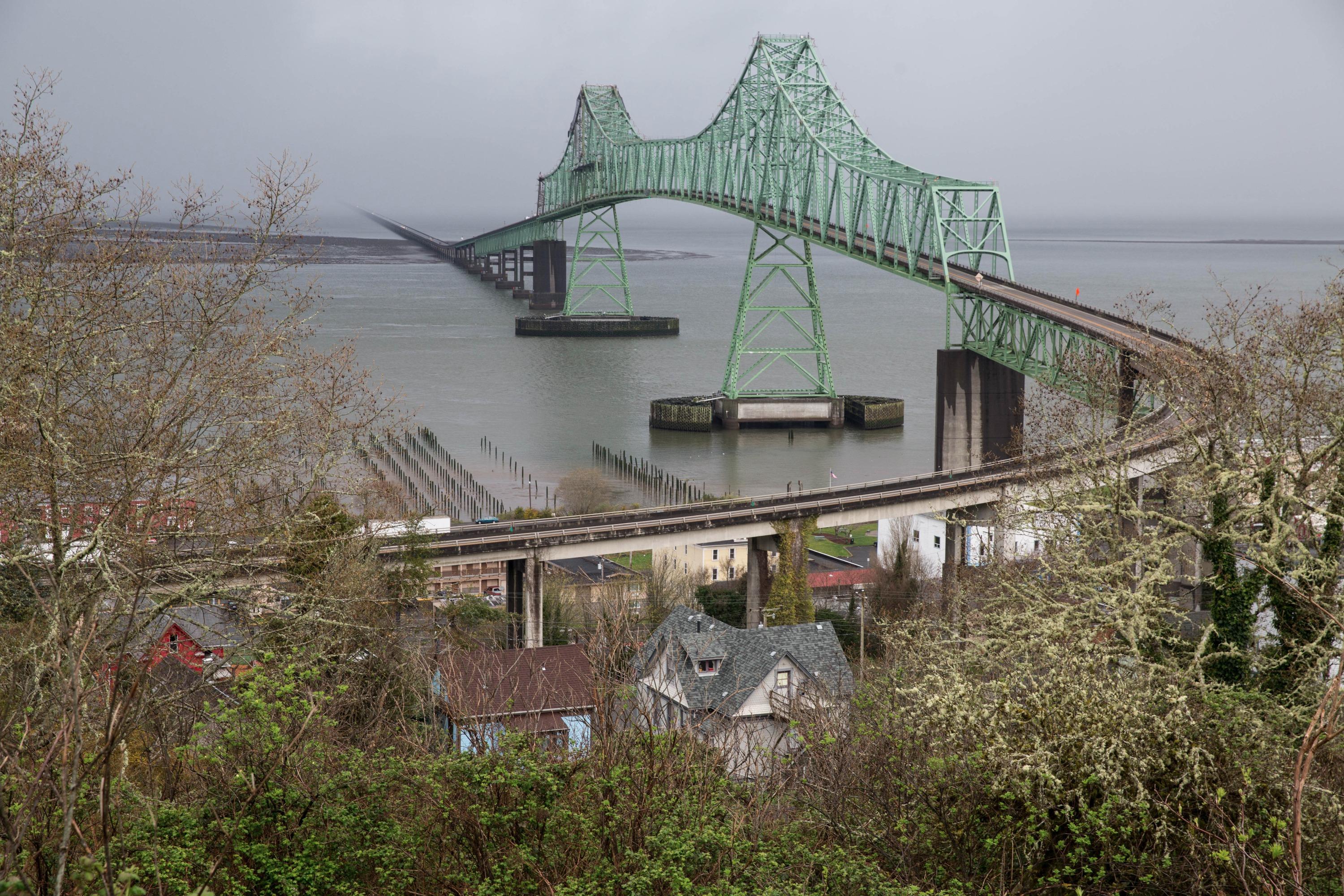
The Astoria-Megler Bridge, designed by Conde McCullough, stretches 4.1 miles between Oregon and Washington. It has been featured in movies such as "The Kindergarten Cop," "Short Circuit" and "The Goonies."
Alan Sylvestre / OPB
In the 1980s, life in Astoria was pretty sleepy. The fish processing and logging industries that had fueled the city’s emergence as a northwestern hub during the 19th century were in steep decline.
“We were sort of a bathroom stop on the way to the beach,” says Paul Benoit, who was Astoria’s planning director in the ‘80s and ‘90s. “I remember when the high school band played at the ribbon cutting when McDonald’s opened. Today, they’d probably picket a corporate franchise development, but back then the city felt like, ‘Wow, we’re on the map; someone noticed us!’”
Combined with the fact that the city had already been built out during the late 19th century, there was very little demand for new housing construction in Astoria in those years. “We saw so little development we’d be lucky to see two new homes built in a year,” Benoit says. Astoria’s leaders were wary of doing anything to disincentivize any developers that wanted to build in town.
But the days of Astoria as a sleepy coastal hamlet are in the past. The city has seen an influx of new restaurants, businesses, and housing in recent years. It’s home to the so-called “Clatsop County fermentation cluster,” with major producers like Pilot House Distilling and Buoy Beer Company. Today, there are four new hotel projects concurrently considering development in the city. Now that the Astoria renaissance is underway, city leaders are working on plans to refurbish the 211-year-old city’s infrastructure; all that wastewater from the breweries and distilleries has to go somewhere, after all.
“When these commercial facilities come online, say hotels — they need firefighting flows,” says Benoit, who today serves as Astoria’s interim city manager. “You need enough water in the pipe, and the pipe needs to be big enough to fight the fire. You get to a point where you actually have to improve a whole section of the system, because the water delivery system may involve a mile of pipe.”
But that mile of pipe ain’t cheap. That’s why the Astoria City Council is now looking to implement a new system development charge program in the city. The city would create a structure of fees that developers pay for the right to build in Astoria, which would then go into a special fund to help pay for the infrastructure improvements the growing city needs.
“You can’t go hire a police officer or put an extra parks employee out there,” Benoit says. “It’s in a fund that’s specifically for future infrastructure improvements.”
System development charges — or SDC’s — are a standard practice in most major cities. Benoit says many developers have come to expect them as an ordinary cost of doing business.
“They found it almost comical that we didn’t have SDCs,” he says. “They haven’t worked in a community that didn’t have them. It’s like, ‘Wow, you just saved me a quarter of a million dollars.’”
Still, implementing a system of SDC’s is complicated. They’re governed by a bundle of complex Oregon statutes, and need to be properly balanced to provide the most benefit without pricing development out of a community. In 2018, the SDC on a new single-family home in Seaside was $9,500; that same year, the construction of the same home in Beaverton cost $31,400 in fees.
“It’s the city’s own decision whether to still incentivize new development by keeping things affordable,” Benoit says, “or whether you want to keep fees at the maximum you’re allowed — a kind of pay-to-play. Astoria’s never been that way; this pressure of development is relatively new to the city.”
These questions will shape the way the city grows into the future as the Astoria City Council considers hiring a consultant to make recommendations on how much the city should charge developers.
Benoit says whatever Astoria does in terms of redevelopment, it’s the city’s priority to make sure new developments resonate with the people who live there — especially the waterfront-centric, working-class community that has called the city home for generations.
“When we were redeveloping the waterfront, we would say our goal was to be gritty, not pretty,” he says. “Back in the ‘80s, there was a very popular bumper sticker that you would see around. It was, ‘We ain’t quaint.’ It was kind of a pushback against visitors saying, ‘Oh your town is so quaint.’ Well, we ain’t quaint! That’s insulting!”
At the end of the day, though, Benoit says he hopes Astoria can maintain a delicate balance of attracting growth while protecting the city’s roots.
“There are a lot of tourists,” Benoit laughs, “but it’s not made to be attractive to tourists. We do it for us, and if visitors like it, great.”
“If not, you can keep driving.”
Listen to Paul Benoit’s conversation with OPB’s John Notarianni using the audio player above




